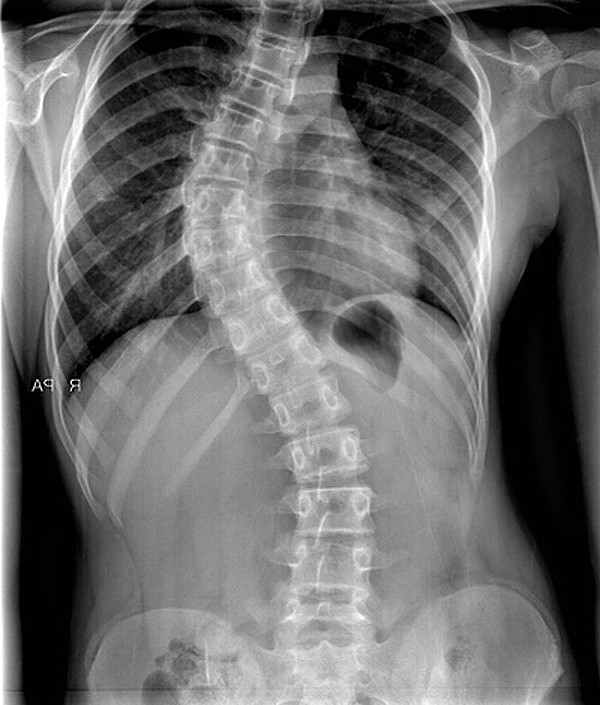Scoliosis facts
- Scoliosis is an abnormal curve in the spine.
- There are several types of scoliosis based on the cause and age when the curve develops; the majority of patients have no known cause.
- The most common symptom of scoliosis is curvature of the spine.
- Scoliosis risk factors include age (9-15-year-olds), female sex, and family history.
- Diagnosis is done by the physical exam and by imaging techniques such as X-rays, CT scans, or MRIs.
- Depending on the severity of the curve and the risk for it getting worse, scoliosis can be treated with observation, bracing, or surgery.
- Orthopedic surgeons or neurosurgeons are often consulted if surgery is needed.
- The prognosis for an individual with scoliosis ranges from mainly good to fair, depending on how early the problem is diagnosed and treated.
- There is no cure for scoliosis, but the symptoms can be reduced.
What is scoliosis?
Scoliosis is a disorder that causes an abnormal curve of the spine, or backbone. The spine has normal curves when looking from the side, but it should appear straight when looking from the front. Kyphosis is a curve in the spine seen from the side in which the spine is bent forward. There is a normal kyphosis in the middle (thoracic) spine. Lordosis is a curve seen from the side in which the spine is bent backward. There is a normal lordosis in the upper (cervical) spine and the lower (lumbar) spine. People with scoliosis develop additional curves to either side of the body, and the bones of the spine twist on each other, forming a “C” or an “S” shape in the spine.
Scoliosis is about two times more common in girls than boys. It can be seen at any age, but it is most common in those over about 10 years of age. Scoliosis is hereditary in that people with scoliosis are more likely to have children with scoliosis; however, there is no correlation between the severity of the curves from one generation to the next.
What causes scoliosis?
Scoliosis affects about 2% of females and 0.5% of males. In most cases, the cause of scoliosis is unknown (known as idiopathic). This type of scoliosis is described based on the age when scoliosis develops, as are other some other types of scoliosis.
- If the person is less than 3 years old, it is called infantile idiopathic scoliosis.
- Scoliosis that develops between 3-10 years of age is called juvenile idiopathic scoliosis.
- People who are over 10 years old (10-18 years old) have adolescent idiopathic scoliosis.
More than 80% of people with scoliosis have idiopathic scoliosis, and the majority of those are adolescent girls; the most common location for scoliosis is in the thoracic spine.
Medical literature often has more specific names or terms for scoliosis:
- Kyphoscoliosis: a combination of outward and lateral spine curvature
- Dextroscoliosis: curvature of the spine to the right
- Rotoscoliosis (rotatory): curvature of the vertebral column turned on its axis
- Levoconvex: curvature of the spine to the left
- Thoracolumbar: curvature related to both the thoracic and lumbar regions of the spine
What are the causes of other types of scoliosis?
As stated above, idiopathic scoliosis and its subtypes comprise over 80% of all scoliosis patients. However, there are three other main types of scoliosis:
- Functional: In this type of scoliosis, the spine is normal, but an abnormal curve develops because of a problem somewhere else in the body. This could be caused by one leg being shorter than the other or by muscle spasms in the back.
- Neuromuscular: In this type of scoliosis, there is a problem when the bones of the spine are formed. Either the bones of the spine fail to form completely or they fail to separate from each other during fetal development. This type of congenital scoliosis develops in people with other disorders, including birth defects, muscular dystrophy, cerebral palsy, or Marfan syndrome (an inherited connective tissue disease). People with these conditions often develop a long C-shaped curve and have weak muscles that are unable to hold them up straight. If the curve is present at birth, it is called congenital. This type of scoliosis is often much more severe and needs more aggressive treatment than other forms of scoliosis.
- Degenerative: Unlike the other forms of scoliosis that are found in children and teens, degenerative scoliosis occurs in older adults. It is caused by changes in the spine due to arthritis known as spondylosis. Weakening of the normal ligaments and other soft tissues of the spine combined with abnormal bone spurs can lead to an abnormal curvature of the spine. The spine can also be affected by osteoporosis, vertebral compression fractures, and disc degeneration.
There are other potential causes of scoliosis, including spine tumors such as osteoid osteoma. This is a benign tumor that can occur in the spine and cause pain. The pain causes people to lean to the opposite side to reduce the amount of pressure applied to the tumor. This can lead to a spinal deformity. In addition, researchers suggest that genetics (hereditary), muscle disorders, and/or abnormal fibrillin metabolism may play a role in causing or contributing to scoliosis development.
What are risk factors for scoliosis?
Age is a risk factor as the symptoms often begin between 9-15 years of age. Being a female increases the risk of scoliosis, and females have a higher risk of worsening spine curvature than males. Although many individuals who develop the problem do not have family members with scoliosis, a family history of scoliosis increases the risk of the disease.

